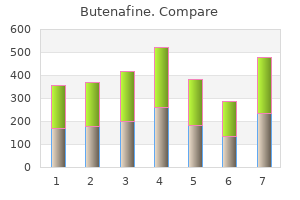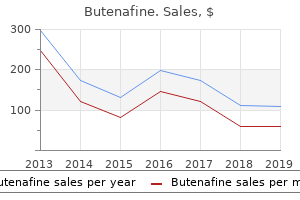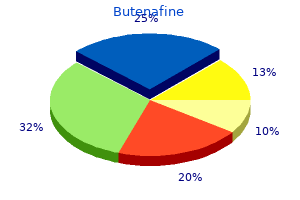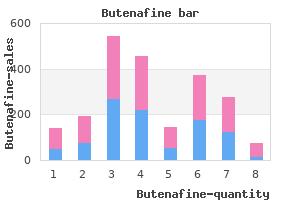

"Generic butenafine 15 gm, anti fungal cleanse".
By: U. Ivan, M.B.A., M.B.B.S., M.H.S.
Program Director, University of Mississippi School of Medicine
The commonest antagonistic unwanted aspect effects of dexmedetomidine seem to be cardiovascular fungus gnats on indoor plants buy cheapest butenafine. Hypotension and hypertension have been reported fungus ergot buy butenafine with amex, the latter thought to be due to fungus gnats eggs purchase discount butenafine line peripheral 2B agonism with peripheral vasoconstriction. Propofol Propofol is a short-acting, sedative-hypnotic intravenous agent that can be utilized to provide moderate or deep sedation. Propofol can induce a deep state of sedation rapidly, present a brief length of effect, and have a pleasing recovery section. Because of the fast onset and restoration following administration, repeated neurologic examinations are simple, corresponding to assessing a toddler with sickle cell disease who comes in with altered psychological status because of a stroke. Unless the patient has indicators or signs of herniation, prophylactic hyperventilation (Paco2 < 35 mmHg) ought to be prevented. Hyperoxia is to be avoided, once a secure airway is obtained, and Fio2 must be titrated to preserve Sao2 greater than 90%. Three percent saline has extra theoretical beneficial effects, together with enhancement of cardiac output, discount of inflammation, restoration of regular mobile resting membrane potential and cell quantity, and stimulation of the release of atrial natriuretic peptide. Repeated doses could be given, but it is strongly recommended to maintain serum osmolality less than 320 mOsm/L. Prophylactic hyperventilation much less to a Paco2 less than 30 mm Hg should be prevented. Elevating the top of the mattress 30 degrees while keeping it within the midline position enhances cerebral venous outflow. Common causes of hydrocephalus embody obstructed ventricular shunts, aqueductal stenosis or compression because of congenital malformations, an infection, posterior fossa tumors, or intracranial bleeding. Hypothermia for Severe Traumatic Brain Injury Hutchinson and colleagues438 printed a multicenter randomized managed trial to investigate using hypothermia as a neuroprotective technique in youngsters. Subsequent evaluation of this examine suggests that the hypothermia group had a significant improve in hypotension and decreased cerebral perfusion pressure that might have contributed to the rise in mortality. After a posterior fossa craniectomy, hemorrhage into the posterior fossa can compromise respiration. If an externalized ventricular drain is present, then output must be rigorously inspected. Because seizure exercise will increase with status epilepticus, brain and skeletal muscle metabolism and oxygen consumption improve and place the kid at risk for cellular hypoxia. During a seizure, airway obstruction and ineffective chest wall and diaphragmatic tour can restrict air flow and worsen arterial hypoxemia and hypercapnia. Treatment of a seizure begins with establishing a patent airway, administering oxygen, and guaranteeing enough ventilation. Commonly used anticonvulsants embody lorazepam, phenobarbital, paraldehyde, and phenytoin. Phenobarbital, 5- to 10- mg/kg boluses (maximal dose of 20 mg/kg), also stops seizures. Giving each phenobarbital and lorazepam collectively exaggerates the respiratory depression. Fosphenytoin can additionally be given intravenously in doses of as much as 20 mg/kg and must be administered slowly to keep away from cardiovascular despair. Finally, an intravenous injection of 1 to 4 mg/kg of sodium thiopental stops most intractable seizures; higher doses of the drug could cause apnea, and the chance of vomiting and aspiration of gastric contents is actual. Once the seizures are under control, the cause of the seizures should be determined. Renal Pharmacology An important aspect of crucial care is the upkeep of acceptable fluid steadiness within the critically sick youngster. The ascending loop diuretic furosemide is likely one of the widely used medicine in pediatric intensive care. The smallest dose necessary to enhance urine output ought to be used, to limit toxicity, together with electrolyte imbalance and ototoxicity.

Katznelson R anti fungal mould wash purchase butenafine australia, Mishaly D fungus gnats in house uk buy butenafine 15gm fast delivery, Hegesh T quinoa anti fungal diet 15gm butenafine visa, et al: Spinal anesthesia for diagnostic cardiac catheterization in high-risk infants, Paediatr Anaesth 15:50-53, 2005. Frawley G, Skinner A, Thomas J, et al: Ropivacaine spinal anesthesia in neonates: a dose vary discovering research, Pediatr Anesth 17: 126-132, 2007. Shenkman Z, Hoppenstein D, Litmanowitz I, et al: Spinal anesthesia in sixty two premature, former-premature or younger infants: technical aspects and pitfalls, Can J Anaesth 49:262-269, 2002. Kokki H, Hendolin H, Turunen M: Postdural puncture headache and transient neurologic signs in children after spinal anesthesia utilizing chopping and pencil level paediatric spinal needles, Acta Anaesthesiol Scand forty two:1076-1082, 1998. In Dalens B, editor: Regional anesthesia in infants, youngsters and adolescents, London, 1995, Williams & Wilkins, pp 275-312. Pande R, Pande M, Bhadani U, et al: Supraclavicular brachial plexus block as a sole anaesthetic technique in children: an analysis of 200 instances, Anaesthesia fifty five:798-802, 2000. Borgeat A, Ekatodramis G, Kalberer F, et al: Acute and nonacute issues associated with interscalene block and shoulder surgical procedure: a prospective research, Anesthesiology 95:875-880, 2001. Tsui B, Suresh S: Ultrasound imaging for regional anesthesia in infants, children, and adolescents: a evaluation of current literature and its utility in the practice of extremity and trunk blocks, Anesthesiology 112:473-492, 2010. Dalens B, Vanneuville G, Tanguy A: A new parascalene method to the brachial plexus in youngsters: comparability with the supraclavicular approach, Anesth Analg 66:1264-1271, 1987. Bigeleisen P, Wilson M: A comparison of two methods for ultrasound guided infraclavicular block, Br J Anaesth ninety six:502-507, 2006. Zimmermann P, Papenfuss T, Schwemmer U, et al: Vertical infraclavicular brachial plexus block in a baby with cystic fibrosis, Anesth Analg ninety five:1825-1826, 2002. Carre P, Joly A, Cluzel Field B, et al: Axillary block in kids: single or multiple injections Dadure C, Raux O, Gaudard P, et al: Continuous psoas compartment blocks after main orthopedic surgery in kids: prospective computed tomographic scan and clinical research, Anesth Analg ninety eight:623-628, 2004. Capdevila X, Macaire P, Dadure C, et al: Continuous compartment block for postoperative analgesia after complete hip arthroplasty: new landmarks, technical pointers and scientific evaluation, Anesth Analg 94:1606-1613, 2002. Kirchmair L, Enna B, Mitterschiffthaler G, et al: Lumbar plexus in youngsters: a sonographic study and its relevance to pediatric regional anesthesia, Anesthesiology one hundred and one:445-450, 2004. Sciard D, Matuszczak M, Gebhard R, et al: Continuous posterior lumbar plexus block for acute postoperative ache management in young children, Anesthesiology ninety five:1521-1523, 2001. Paut O, Sallabery M, Schreiber-Deturmeny E, et al: Continuous fascia iliaca compartment block in youngsters: a prospective evaluation of plasma bupivacaine concentrations, pain scores, and unwanted aspect effects, Anesth Analg ninety two:1159-1163, 2001. Dalens B, Vanneuville G, Tanguy A: Comparison of the fascia iliaca compartment block with the 3-in-1 block in kids, Anesth Analg sixty nine:705-713, 1989. Dalens B, Tanguy A, Vanneuville G: Sciatic nerve blocks in youngsters: comparability of the posterior, anterior, and lateral approaches in a hundred and eighty pediatric patients, Anesth Analg 70:131-137, 1990. Ivani G, Codipietro L, Gagliardi F, et al: A long-term steady infusion by way of a sciatic catheter in a 3-year-old boy, Paediatr Anaesth thirteen:718-721, 2003. Vas L: Continuous sciatic block for leg and foot surgical procedure in 160 youngsters, Pediatr Anesth 15:971-978, 2005. Dadure C, Bringuier S, Nicolas F, et al: Continuous epidural block versus steady popliteal nerve block for postoperative ache relief after major podiatric surgical procedure in youngsters: a potential comparative randomized study, Anesth Analg 102:744-749, 2006. Shah R, Sabanathan S, Richardson J, et al: Continuous paravertebral block for publish thoracotomy analgesia in children, J Cardiovasc Surg 38:543-546, 1997. Berta E, Spanhel J, Smakal O, et al: Single injection paravertebral block for renal surgery in youngsters, Paediatr Anaesth 18:593-597, 2008. Mesnil M, Dadure C, Captier G, et al: A new approach for perioperative analgesia of cleft palate repair in infants: the bilateral suprazygomatic maxillary nerve block, Paediatr Anaesth 20: 343-349, 2010. Sola C, Raux O, Savath L, et al: Ultrasound steering traits and efficiency of suprazygomatic maxillary nerve blocks in infants: a descriptive potential research, Paediatr Anaesth 22: 841-846, 2012. Cregg N, Conway F, Casey W: Analgesia after otoplasty: regional nerve blockade vs local anaesthetic infiltration of the ear, Can J Anaesth forty three:141-147, 1996. Greher M, Moriggl B, Curatolo M, et al: Sonographic visualization and ultrasound-guided blockade of the higher occipital nerve: a comparability of two selective methods confirmed by anatomical dissection, Br J Anaesth 104:637-642, 2010. Dieudonne N, Gomola A, Bonnichon P, et al: Prevention of postoperative pain after thyroid surgical procedure: a double-blind randomized examine of bilateral superficial cervical plexus blocks, Anesth Analg 92:1538-1542, 2001. Suresh S, Templeton L: Superficial cervical plexus block for vocal cord surgery in an awake pediatric patient, Anesth Analg 98: 1556-1557, 2004. Monso A, Riudeubas J, Palanques F, et al: A new application for superior laryngeal nerve block: treatment or prevention of laryngospasm and stridor, Reg Anesth Pain Med 24:186-187, 1999. Agarwal V, Joseph B: Recurrent migratory sympathetically maintained ache syndrome in a child: a case report, J Pediatr Orthop B 15:73-74, 2006.

Pulmonary damage attributable to warmth or smoke inhalation fungal watch order butenafine 15 gm line, or both antifungal meds 15gm butenafine, might necessitate prolonged tracheal intubation and mechanical-controlled air flow fungus gnat off uk order butenafine 15gm amex. Humidification, bronchoscopy, and management of carbon monoxide or cyanide toxicity could additionally be wanted. Safety of Laser Products � Part 8: Guidelines for the safe use of laser beams on humans. Food and Drug Administration: Suggested State Regulations for Control of Radiation: Lasers, vol 2. Agreement renewing an Alliance between the Occupational Safety and Health Administration and the Laser Institute of America. Einstein A: �ber einen die Erzeugung und Verwandlung des Lichtes detreffenden heuristischen Gesichtspunkt, Ann Physik 322:132-148, 1905. Pearce J: Mathematical models of laser-induced tissue thermal harm, Int J Hyperthermia 27:741-750, 2011. Goon P, Sonnex C, Jani P, et al: Recurrent respiratory papillomatosis: an outline of current pondering and remedy, Eur Arch Otorhinolaryngol 265:147-151, 2008. Food and Drug Administration: Suggested state laws for control of radiation: lasers, vol 2. American Society of Anesthesiologists Task Force on Operating Room Fires: Practice Advisory for the Prevention and Management of Operating Room Fires: an Updated Report by the American Society of Anesthesiologists Task Force on Operating Room Fires, Anesthesiology 118(2):271-290, 2013. Agreement renewing an Alliance between the Occupational Safety and Health Administration and the Laser Institute of America, 2007. Kunachak S, Sithisarn P, Kulapaditharom B: Are laryngeal papilloma virus-infected cells viable in the plume derived from continuous mode carbon dioxide laser, are they infectious Orhan-Sungur M, Komatsu R, Sherman A, et al: Effect of nasal cannula oxygen administration focus on facial and adjoining landmarks, Anaesthesia sixty four:521-526, 2009. Reddy C, Majid A, Michaud G, et al: Gas embolism following bronchoscopic argon plasma coagulation: a case collection, Chest 134(5):1066-1069, 2008. Bauman N: Problem laser endotracheal tubes: one company is plagued with lawsuits and accidents, J Clin Laser Med Surg 8:4-7, 1990. Sosis M, Kelanic S, Caldarelli D: An in vitro analysis of a new laser resistant endotracheal tube the Rusch Lasertubus, Anesthesiology 87S:A483, 1997. Eng, who were contributing authors to this subject within the prior version of this work. Key Points � the use of ambulatory surgery continues to improve, principally because of much less invasive surgical procedure, improved patient selection and preparation, and an enlargement in office-based practice. Of prime importance, experience and careful consideration to detail are required to ship highquality speedy recovery with minimal side effects. The decreased need for opioids decreases the incidence and intensity of opposed results. Multimodal regimens are required for sufferers and procedures known to be related to increased risk for complications. One essential element of success in ambulatory surgery and anesthesia is minimal postoperative nausea and vomiting. Ambulatory surgical procedure has its origins in Glasgow, Scotland, the place, between 1898 and 1908, James Henderson Nicoll carried out virtually 9000 ambulatory surgical procedure procedures on youngsters, practically half of whom youthful than 3 years of age. A few years later, Ralph Milton Waters opened his Downtown Anesthesia Clinic in Sioux City, Iowa, permitting grownup patients to return residence inside a couple of hours of inauspicious dental extractions, abscess drainage, or discount of minor fractures. Ambulatory surgery has expanded far beyond performing easy procedures on healthy sufferers. Currently, a broad vary of major procedures are carried out in patients who frequently have complex preexisting medical circumstances. The availability of improved anesthetic and analgesic medicine minimizes the anesthetic unwanted effects and facilitates the restoration process, as do the increasing availability of minimally invasive surgical methods. Equally essential has been a philosophical change that challenged outdated and conservative practices, demanding inpatient procedures. Ambulatory surgery now accounts for approximately 80% of the elective surgical procedures in the United States. Patients respect the more efficient scheduling of surgical procedure, not requiring the provision of a hospital bed, and the comfort and convenience of recovering in the familiar home environment. Financial advantages exist to ambulatory surgical procedure in eliminating the costs related to overnight admission. In both the United States and the United Kingdom, procedures that are appropriate with ambulatory surgery obtain the identical cost (from insurance coverage companies and regional finances holders, respectively), no matter the size of stay.

De Luca D anti fungal wash for horses order online butenafine, et al: the usage of the Berlin definition for acute respiratory distress syndrome throughout infancy and early childhood: multicenter evaluation and skilled consensus kill fungus gnats uk cheapest generic butenafine uk, Intensive Care Med 39(12):2083-2091 antifungal cream walmart butenafine 15gm visa, 2013. The Acute Respiratory Distress Syndrome Network, N Engl J Med 342(18):1301-1308, 2000. Villar J, et al: A excessive optimistic end-expiratory pressure, low tidal quantity ventilatory technique improves consequence in persistent acute respiratory distress syndrome: a randomized, managed trial, Crit Care Med 34(5):1311-1318, 2006. Rubin S, et al: Effort of inhaling youngsters receiving high-flow nasal cannula, Pediatr Crit Care Med 15(1):1-6, 2014. Yang Y, et al: Positive finish expiratory strain titrated by transpulmonary strain improved oxygenation and respiratory mechanics in acute respiratory misery syndrome sufferers with intra-abdominal hypertension, Chin Med J (Engl) 126(17):3234-3239, 2013. Reber A, et al: Effect of airway opening manoeuvres on thoracoabdominal asynchrony in anaesthetized children, Eur Respir J 17(6):1239-1243, 2001. Reber A, et al: Effect of continuous optimistic airway stress on the measurement of thoracoabdominal asynchrony and minute air flow in kids anesthetized with sevoflurane and nitrous oxide, Chest 122(2):473-478, 2002. McKiernan C, et al: High circulate nasal cannulae therapy in infants with bronchiolitis, J Pediatr 156(4):634-638, 2010. Schibler A, et al: Reduced intubation rates for infants after introduction of high-flow nasal prong oxygen delivery, Intensive Care Med 37(5):847-852, 2011. Hegde S, Prodhan P: Serious air leak syndrome complicating high-flow nasal cannula therapy: a report of three instances, Pediatrics 131(3):e939-e944, 2013. Basnet S, et al: Safety, efficacy, and tolerability of early initiation of noninvasive optimistic pressure air flow in pediatric sufferers admitted with standing asthmaticus: a pilot research, Pediatr Crit Care Med 13(4):393-398, 2012. Koninckx M, Buysse C, de Hoog M: Management of standing asthmaticus in children, Paediatr Respir Rev 14(2):78-85, 2013. Mancebo J, et al: A multicenter trial of prolonged prone air flow in extreme acute respiratory distress syndrome, Am J Resp Crit Care Med 173(11):1233-1239, 2006. Guerin C, et al: Prone positioning in severe acute respiratory distress syndrome, N Engl J Med 368(23):2159-2168, 2013. Thelandersson A, Cider A, Nellgard B: Prone place in mechanically ventilated patients with reduced intracranial compliance, Acta Anaesthesiol Scan 50(8):937-941, 2006. Beuret P, et al: Prone position as prevention of lung harm in comatose sufferers: a potential, randomized, controlled study, Intensive Care Med 28(5):564-569, 2002. Chavez A, dela Cruz R, Zaritsky A: Spontaneous respiration trial predicts profitable extubation in infants and kids, Pediatr Crit Care Med 7(4):324-328, 2006. Esteban A, et al: Extubation outcome after spontaneous respiration trials with T-tube or strain help ventilation. The Spanish Lung Failure Collaborative Group, Am J Respir Crit Care Med 156(2 Pt 1):459-465, 1997. Manczur T, et al: Resistance of pediatric and neonatal endotracheal tubes: affect of flow fee, size, and form, Crit Care Med 28(5):1595-1598, 2000. Use of intermittent positive-pressure respiratory and racemic epinephrine, Am J Dis Child 129(7):790-793, 1975. Nicolai T, Pohl A: Acute viral bronchiolitis in infancy: epidemiology and management, Lung 168(Suppl):396-405, 1990. The present state of lung transplantation for cystic fibrosis, Thorax 46(3):213-216, 1991. Bader D, et al: Childhood sequelae of infant lung illness: exercise and pulmonary operate abnormalities after bronchopulmonary dysplasia, J Pediatr 110(5):693-699, 1987. Gerhardt T, et al: Serial determination of pulmonary function in infants with persistent lung illness, J Pediatr 110(3):448-456, 1987. Abbasi S, et al: Pulmonary mechanics in preterm neonates with respiratory failure treated with high-frequency oscillatory air flow compared with conventional mechanical air flow, Pediatrics 87(4):487-493, 1991. Weissberg D, Schwartz I: Foreign our bodies within the tracheobronchial tree, Chest 91(5):730-733, 1987. Kelly A, et al: A comparability of heart rate adjustments related to levalbuterol and racemic albuterol in pediatric cardiology patients, Ann Pharmacother 47(5):644-650, 2013. Appendini L, et al: Physiologic response of ventilator-dependent sufferers with continual obstructive pulmonary disease to proportional assist air flow and continuous constructive airway strain, Am J Respir Crit Care Med 159(5 Pt 1):1510-1517, 1999. Kong W, et al: Effects of extrinsic optimistic end-expiratory stress on cardiopulmonary perform in sufferers with persistent obstructive pulmonary disease, Chin Med J (Engl) 114(9):912-915, 2001.
Butenafine 15gm amex. fungal Infection Treatment At Home ! Skin Infection Treatment.

Unfortunately saprophytic fungus definition cheap butenafine 15gm otc, therapy of pulmonary hypertension with intravenous vasodilators might worsen the systemic hypotension fungus xm order 15gm butenafine with visa. Food and Drug Administration in 1999 anti fungal wash for humans butenafine 15 gm with visa, by the European Medicine Evaluation Agency and European Commission in 2001, and by the Ministry of Health, Labour and Welfare in Japan in 2008. Enhancement of Ventilation-Perfusion Matching by Nitric Oxide Inhalation the intrapulmonary distribution of blood circulate and ven tilation (ventilation-perfusion [V/Q] distribution) is a serious determinant of the efficiency of transpulmonary oxygenation and determines the partial arterial stress of oxygen (PaO2). The shunt from the right to the left side of the circulation is especially extrapulmonary. Diagram illustrating the differing pathophysiologic results of inhaled pulmonary vasodilators and intravenous vasodilators. Studies in newborns counsel that untimely constriction of the ductus arteriosus, septic mediators, and meconium aspiration all cause pulmonary endothelial cell injury. Lung injury decreases alveolar and pulmonary microvascular growth in untimely lambs and baboons and in newborn mice and rats. Demonstration of a optimistic response to vasodilating brokers in sufferers with pulmonary hypertension correlates with an improved long-term clinical outcome and has been used to guide medical remedy. Hypoxic pulmonary vasoconstriction diverts venous blood move to better-ventilated lung regions, thereby bettering arterial oxygenation. Patients with continual mitral valve disease may have preoperative pulmonary hypertension caused by retrograde transmission of an elevated left atrial pressure (also see Chapter 67). After mitral valve restore or substitute, pulmonary vascular remodeling and vasoconstriction may persist or slowly decrease. Pulmonary hypertension within the recipient undergoing cardiac transplantation is a serious reason for right coronary heart failure and early death. Ischemia-reperfusion (I-R) injury is probably certainly one of the major causes of early graft failure after lung transplantation. Adhesion and sequestration of activated leukocytes by activated pulmonary endothelium are believed to be important mechanisms of I-R damage. Coronary perfusion was stopped for 30 minutes, followed by reperfusion for 40 minutes. Observations in rodents have just lately been extended to a clinically related porcine model of cardiac I-R injury. Although some studies have reported encouraging leads to the perioperative off-label use of those medication by way of off-label route of administration. As a outcome, no basic consensus exists as to when and the way to use these inhaled vasodilators. Diagram illustrating a pattern setup of inhaled administration of epoprostenol in patients on ventilation. A large number of laboratory and medical analysis research have been performed to delineate its biochemistry, physiologic characteristics, unwanted facet effects, and clinical efficacy in numerous diseases of children and adults. It is important that a single examine of a particular illness state not influence an analysis of this advanced area. In adults, inhaled epoprostenol (30,000 ng/mL) is administered using a syringe pump and jet nebulizer linked to the inspiratory limb of the ventilator163. Furthermore, epoprostenol must be dissolved in a extremely viscous and basic glycine diluent (pH = 10. Further research appropriately designed to handle these points are wanted to better outline the function of different much less selective inhaled pulmonary vasodilators. It is characterized by pulmonary vasoselectivity, and it additionally increases arterial oxygenation and enhances pulmonary V/Q matching by rising Chapter 104: Nitric Oxide and Other Inhaled Pulmonary Vasodilators 41. A selective pulmonary vasodilator reversing hypoxic pulmonary vasoconstriction, Circulation 83:2038-2047, 1991. The Neonatal Inhaled Nitric Oxide Study Group: Inhaled nitric oxide in full-term and practically full-term infants with hypoxic respiratory failure, N Engl J Med 336:597-604, 1997. Mourgeon E, Levesque E, Duveau C, et al: Factors influencing indoor concentrations of nitric oxide in a Parisian intensive care unit, Am J Respir Crit Care Med 156:1692-1695, 1997. Barst R, Channick R, Ivy D, Goldstein B: Clinical views with long-term pulsed inhaled nitric oxide for the treatment of pulmonary arterial hypertension, Pulm Circ 2:139-147, 2012. A bronchodilator in delicate asthmatics with methacholine-induced bronchospasm, Am J Respir Crit Care Med 153:128-135, 1996. Bourbon J, Boucherat O, Chailley-Heu B, Delacourt C: Control mechanisms of lung alveolar development and their problems in bronchopulmonary dysplasia, Pediatr Res 57:38R-46R, 2005. Benzing A, Geiger K: Inhaled nitric oxide lowers pulmonary capillary strain and adjustments longitudinal distribution of pulmonary vascular resistance in patients with acute lung harm, Acta Anaesthesiol Scand 38:640-645, 1994.